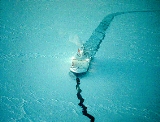
Icebreaker
Encyclopedia
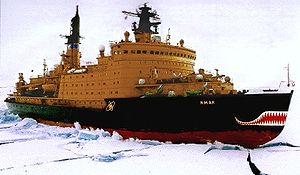

Ship
Since the end of the age of sail a ship has been any large buoyant marine vessel. Ships are generally distinguished from boats based on size and cargo or passenger capacity. Ships are used on lakes, seas, and rivers for a variety of activities, such as the transport of people or goods, fishing,...
or boat
Boat
A boat is a watercraft of any size designed to float or plane, to provide passage across water. Usually this water will be inland or in protected coastal areas. However, boats such as the whaleboat were designed to be operated from a ship in an offshore environment. In naval terms, a boat is a...
designed to move and navigate through ice
Ice
Ice is water frozen into the solid state. Usually ice is the phase known as ice Ih, which is the most abundant of the varying solid phases on the Earth's surface. It can appear transparent or opaque bluish-white color, depending on the presence of impurities or air inclusions...
-covered waters. Although the term usually refers to ice-breaking ship
Ship
Since the end of the age of sail a ship has been any large buoyant marine vessel. Ships are generally distinguished from boats based on size and cargo or passenger capacity. Ships are used on lakes, seas, and rivers for a variety of activities, such as the transport of people or goods, fishing,...
s, it may also refer to smaller vessels (e.g., icebreaking boats that were used on the canals of Great Britain in the days of commercial carrying).
For a ship to be considered an icebreaker, it requires three traits most normal ships lack: a strengthened hull, an ice-clearing shape, and the power to push through ice-covered waters.
To pass through ice-covered water, an icebreaker uses its great momentum and power to drive its bow
Bow (ship)
The bow is a nautical term that refers to the forward part of the hull of a ship or boat, the point that is most forward when the vessel is underway. Both of the adjectives fore and forward mean towards the bow...
up onto the ice, breaking the ice under the immense weight of the ship. Because a buildup of broken ice in front of a ship can slow it down much more than the breaking of the ice itself, the speed of the ship is increased by having a specially designed hull to direct the broken ice around or under the vessel. The external components of the ship's propulsion system (propeller
Propeller
A propeller is a type of fan that transmits power by converting rotational motion into thrust. A pressure difference is produced between the forward and rear surfaces of the airfoil-shaped blade, and a fluid is accelerated behind the blade. Propeller dynamics can be modeled by both Bernoulli's...
s, propeller shafts, etc.) are at even greater risk of damage than the vessel's hull, so the ability of an icebreaker to propel itself onto the ice, break it, and clear the debris from its path successfully is essential for its safety.
Sailing ships in the polar waters
Even in the earliest days of polar exploration, ice-strengthened ships were used. These were originally wooden and based on existing designs, but reinforced, particularly around the waterlineWaterline
The term "waterline" generally refers to the line where the hull of a ship meets the water surface. It is also the name of a special marking, also known as the national Load Line or Plimsoll Line, to be positioned amidships, that indicates the draft of the ship and the legal limit to which a ship...
with double planking to the hull and strengthening cross members inside the ship. Bands of iron were wrapped around the outside. Sometimes metal sheeting was placed at the bows, stern and along the keel. Such strengthening was designed to help the ship push through ice and also to protect the ship in case it was "nipped" by the ice. Nipping occurs when ice floes around a ship are pushed against the ship, trapping it as if in a vice and causing damage. This vice-like action is caused by the force of winds and tides on ice formations. Although such wind and tidal forces may be exerted many miles away, the ice transmits the force.
The first boats to be used in the polar waters were that of the indigenous Arctic
Arctic
The Arctic is a region located at the northern-most part of the Earth. The Arctic consists of the Arctic Ocean and parts of Canada, Russia, Greenland, the United States, Norway, Sweden, Finland, and Iceland. The Arctic region consists of a vast, ice-covered ocean, surrounded by treeless permafrost...
people. The kayak
Kayak
A kayak is a small, relatively narrow, human-powered boat primarily designed to be manually propelled by means of a double blade paddle.The traditional kayak has a covered deck and one or more cockpits, each seating one paddler...
is the most famous type of a small human-powered boat with a covered deck, and one or more cockpits, each seating one paddler who strokes a double-bladed paddle
Paddle
A paddle is a tool used for pushing against liquids, either as a form of propulsion in a boat or as an implement for mixing.-Materials and designs:...
. Such boats, of course, have no icebreaking capabilities, but they are light and well fit to carry over the ice.
In the 9th and 10th centuries, the Viking expansion
Viking expansion
The Vikings sailed most of the North Atlantic, reaching south to North Africa and east to Russia, Constantinople and the Middle East, as looters, traders, colonists, and mercenaries...
reached the North Atlantic, and eventually Greenland
Greenland
Greenland is an autonomous country within the Kingdom of Denmark, located between the Arctic and Atlantic Oceans, east of the Canadian Arctic Archipelago. Though physiographically a part of the continent of North America, Greenland has been politically and culturally associated with Europe for...
and Svalbard
Svalbard
Svalbard is an archipelago in the Arctic, constituting the northernmost part of Norway. It is located north of mainland Europe, midway between mainland Norway and the North Pole. The group of islands range from 74° to 81° north latitude , and from 10° to 35° east longitude. Spitsbergen is the...
in the Arctic
Arctic
The Arctic is a region located at the northern-most part of the Earth. The Arctic consists of the Arctic Ocean and parts of Canada, Russia, Greenland, the United States, Norway, Sweden, Finland, and Iceland. The Arctic region consists of a vast, ice-covered ocean, surrounded by treeless permafrost...
. Vikings, however, operated their ships in the waters that were ice-free for the most part of the year, in the conditions of the Medieval Warm Period
Medieval Warm Period
The Medieval Warm Period , Medieval Climate Optimum, or Medieval Climatic Anomaly was a time of warm climate in the North Atlantic region, that may also have been related to other climate events around the world during that time, including in China, New Zealand, and other countries lasting from...
.
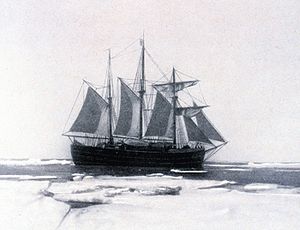
Russians
The Russian people are an East Slavic ethnic group native to Russia, speaking the Russian language and primarily living in Russia and neighboring countries....
started settling the coasts of the White Sea
White Sea
The White Sea is a southern inlet of the Barents Sea located on the northwest coast of Russia. It is surrounded by Karelia to the west, the Kola Peninsula to the north, and the Kanin Peninsula to the northeast. The whole of the White Sea is under Russian sovereignty and considered to be part of...
, named so for being ice-covered for over half of a year. The ethnic subgroup of Russians
Russians
The Russian people are an East Slavic ethnic group native to Russia, speaking the Russian language and primarily living in Russia and neighboring countries....
that lived on the shores of the Arctic Ocean
Arctic Ocean
The Arctic Ocean, located in the Northern Hemisphere and mostly in the Arctic north polar region, is the smallest and shallowest of the world's five major oceanic divisions...
became known as Pomors
Pomors
Pomors or Pomory are Russian settlers and their descendants on the White Sea coast. It is also term of self-identification for the descendants of Russian, primarily Novgorod, settlers of Pomorye , living on the White Sea coasts and the territory whose southern border lies on a watershed which...
("seaside settlers"). Gradually they developed a special type of small one or two mast wooden sailing ship
Sailing ship
The term sailing ship is now used to refer to any large wind-powered vessel. In technical terms, a ship was a sailing vessel with a specific rig of at least three masts, square rigged on all of them, making the sailing adjective redundant. In popular usage "ship" became associated with all large...
s, used for voyages in the ice conditions of the Arctic
Arctic
The Arctic is a region located at the northern-most part of the Earth. The Arctic consists of the Arctic Ocean and parts of Canada, Russia, Greenland, the United States, Norway, Sweden, Finland, and Iceland. The Arctic region consists of a vast, ice-covered ocean, surrounded by treeless permafrost...
seas and later on Siberia
Siberia
Siberia is an extensive region constituting almost all of Northern Asia. Comprising the central and eastern portion of the Russian Federation, it was part of the Soviet Union from its beginning, as its predecessor states, the Tsardom of Russia and the Russian Empire, conquered it during the 16th...
n rivers. These earliest icebreakers were called kochi
Koch (boat)
The Koch was a special type of small one or two mast wooden sailing ships designed and used in Russia for transpolar voyages in ice conditions of the Arctic seas, popular among the Pomors....
. Koch's hull was protected by a belt of ice-floe resistant flush skin-planking (made of oak
Oak
An oak is a tree or shrub in the genus Quercus , of which about 600 species exist. "Oak" may also appear in the names of species in related genera, notably Lithocarpus...
or larch
Larch
Larches are conifers in the genus Larix, in the family Pinaceae. Growing from 15 to 50m tall, they are native to much of the cooler temperate northern hemisphere, on lowlands in the north and high on mountains further south...
) along the variable water-line, and had a false keel for on-ice portage
Portage
Portage or portaging refers to the practice of carrying watercraft or cargo over land to avoid river obstacles, or between two bodies of water. A place where this carrying occurs is also called a portage; a person doing the carrying is called a porter.The English word portage is derived from the...
. If a koch became squeezed by the ice-fields, its rounded bodylines below the water-line would allow for the ship to be pushed up out of the water and onto the ice with no damage.
In the 19th century, similar protective measures were adopted to modern steam-powered icebreakers. Some notable sailing ships in the end of the Age of Sail
Age of Sail
The Age of Sail was the period in which international trade and naval warfare were dominated by sailing ships, lasting from the 16th to the mid 19th century...
also featured the egg-shaped form alike that of Pomor boats, for example the famous Fram
Fram
Fram is a ship that was used in expeditions of the Arctic and Antarctic regions by the Norwegian explorers Fridtjof Nansen, Otto Sverdrup, Oscar Wisting, and Roald Amundsen between 1893 and 1912...
, used by Fridtjof Nansen
Fridtjof Nansen
Fridtjof Wedel-Jarlsberg Nansen was a Norwegian explorer, scientist, diplomat, humanitarian and Nobel Peace Prize laureate. In his youth a champion skier and ice skater, he led the team that made the first crossing of the Greenland interior in 1888, and won international fame after reaching a...
and other great Norwegian
Norway
Norway , officially the Kingdom of Norway, is a Nordic unitary constitutional monarchy whose territory comprises the western portion of the Scandinavian Peninsula, Jan Mayen, and the Arctic archipelago of Svalbard and Bouvet Island. Norway has a total area of and a population of about 4.9 million...
Polar explorers. Fram is said to be the wooden ship to have sailed farthest north (85°57'N) and farthest south (78°41'S), and perhaps the strongest wooden ship ever built.
Steam-powered icebreakers
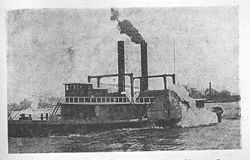
Paddle steamer
A paddle steamer is a steamship or riverboat, powered by a steam engine, using paddle wheels to propel it through the water. In antiquity, Paddle wheelers followed the development of poles, oars and sails, where the first uses were wheelers driven by animals or humans...
, City Ice Boat No. 1
USS Ice Boat (1861)
USS Ice Boat was a vessel borrowed from the City of Philadelphia, Pennsylvania, by the Union Navy when the American Civil War suddenly broke out...
, that was built for the city of Philadelphia by Vandusen & Birelyn in 1837. The ship's wooden paddles, powered by two 250-horsepower steam engines, were reinforced with iron coverings.
The first European steam-powered icebreaker, as well as the first ever metal
Metal
A metal , is an element, compound, or alloy that is a good conductor of both electricity and heat. Metals are usually malleable and shiny, that is they reflect most of incident light...
-hull icebreaker was the Russian Pilot
Pilot (icebreaker)
Pilot was a Russian icebreaker, the world's first steam-powered and metal-ship icebreaker of modern type.Pilot had originally been built as a steam-powered propeller tug. It had the bow altered to achieve an ice-clearing capability . Conversion had been done in 1864 under an order of its owner,...
, built in 1864 on orders of merchant and shipbuilder Mikhail Britnev
Mikhail Britnev
Mikhail Osipovich Britnev was a Russian shipowner and shipbuilder, who created the first metal-hull icebreaker called Pilot in 1864.- References :*...
. It had the bow altered to achieve an ice-clearing capability (20° raise from keel line). This allowed the Pilot to push itself on the top of the ice and consequently break it. Britnev fashioned the bow of his ship after the shape of old Pomor boats, which had been navigating icy waters of the White Sea
White Sea
The White Sea is a southern inlet of the Barents Sea located on the northwest coast of Russia. It is surrounded by Karelia to the west, the Kola Peninsula to the north, and the Kanin Peninsula to the northeast. The whole of the White Sea is under Russian sovereignty and considered to be part of...
and Barents Sea
Barents Sea
The Barents Sea is a marginal sea of the Arctic Ocean, located north of Norway and Russia. Known in the Middle Ages as the Murman Sea, the sea takes its current name from the Dutch navigator Willem Barents...
for centuries. Pilot was used between 1864-1890 for navigation in the Gulf of Finland
Gulf of Finland
The Gulf of Finland is the easternmost arm of the Baltic Sea. It extends between Finland and Estonia all the way to Saint Petersburg in Russia, where the river Neva drains into it. Other major cities around the gulf include Helsinki and Tallinn...
between Kronstadt
Kronstadt
Kronstadt , also spelled Kronshtadt, Cronstadt |crown]]" and Stadt for "city"); is a municipal town in Kronshtadtsky District of the federal city of St. Petersburg, Russia, located on Kotlin Island, west of Saint Petersburg proper near the head of the Gulf of Finland. Population: It is also...
and Oranienbaum
Oranienbaum
Oranienbaum may refer to:Germany:* Oranienbaum, Germany, a town in Saxony-Anhalt, Germany* Oranienbaum-WörlitzRussia:* Oranienbaum, Russia , a Russian royal residence* Lomonosov , the former name of the adjacent town...
thus extending the summer navigation season by several weeks. Inspired by the success of the Pilot, Mikhail Britnev built a second similar vessel Boy ("Battle" in Russian) in 1875 and a third Booy ("Buoy" in Russian) in 1889.
The cold winter of 1870-1871 led to the international recognition of Britnev's design. That year the Elbe River and the port of Hamburg
Hamburg
-History:The first historic name for the city was, according to Claudius Ptolemy's reports, Treva.But the city takes its modern name, Hamburg, from the first permanent building on the site, a castle whose construction was ordered by the Emperor Charlemagne in AD 808...
froze, which caused a prolonged halt of navigation and huge commercial losses. In such circumstances, Germans purchased the Pilot
Pilot (icebreaker)
Pilot was a Russian icebreaker, the world's first steam-powered and metal-ship icebreaker of modern type.Pilot had originally been built as a steam-powered propeller tug. It had the bow altered to achieve an ice-clearing capability . Conversion had been done in 1864 under an order of its owner,...
s design from Britnev for some 300 ruble
Ruble
The ruble or rouble is a unit of currency. Currently, the currency units of Belarus, Russia, Abkhazia, South Ossetia and Transnistria, and, in the past, the currency units of several other countries, notably countries influenced by Russia and the Soviet Union, are named rubles, though they all are...
s. Thus the German Eisbrecher I appeared in 1871, and other European countries soon followed the suit.
With its rounded shape and strong metal hull, Pilot
Pilot (icebreaker)
Pilot was a Russian icebreaker, the world's first steam-powered and metal-ship icebreaker of modern type.Pilot had originally been built as a steam-powered propeller tug. It had the bow altered to achieve an ice-clearing capability . Conversion had been done in 1864 under an order of its owner,...
had all the main features present in the modern icebreakers, of which is why it is often considered the first true icebreaker. Another contender for this title is icebreaker Yermak
Icebreaker Yermak
Yermak was a Russian and later Soviet icebreaker, the first polar icebreaker in the world, having a strengthened hull shaped to ride over and crush pack ice....
, built in England
England
England is a country that is part of the United Kingdom. It shares land borders with Scotland to the north and Wales to the west; the Irish Sea is to the north west, the Celtic Sea to the south west, with the North Sea to the east and the English Channel to the south separating it from continental...
for Russia
Russia
Russia or , officially known as both Russia and the Russian Federation , is a country in northern Eurasia. It is a federal semi-presidential republic, comprising 83 federal subjects...
according to the design of Admiral Stepan Makarov
Stepan Makarov
Stepan Osipovich Makarov was a Ukrainian - born Russian vice-admiral, a highly accomplished and decorated commander of the Imperial Russian Navy, an oceanographer, awarded by the Russian Academy of Sciences, and author of several books. Makarov also designed a small number of ships...
and under his supervision. Makarov borrowed the main principles from Pilot
Pilot (icebreaker)
Pilot was a Russian icebreaker, the world's first steam-powered and metal-ship icebreaker of modern type.Pilot had originally been built as a steam-powered propeller tug. It had the bow altered to achieve an ice-clearing capability . Conversion had been done in 1864 under an order of its owner,...
and applied them for creation of the first polar icebreaker, which was able to run over and crush pack ice. Between 1899-1911 Yermak sailed in heavy ice conditions for more than 1000 days.
At the beginning of the 20th century, several other countries began to operate purpose-built icebreakers. Most were coastal icebreakers, but Russia
Russia
Russia or , officially known as both Russia and the Russian Federation , is a country in northern Eurasia. It is a federal semi-presidential republic, comprising 83 federal subjects...
, and later, the Soviet Union
Soviet Union
The Soviet Union , officially the Union of Soviet Socialist Republics , was a constitutionally socialist state that existed in Eurasia between 1922 and 1991....
, also built several oceangoing icebreakers of around 10,000 ton displacement, eventually converting to diesel-electric
Diesel-electric
Diesel-electric transmission or diesel-electric powertrain is used by a number of vehicle and ship types for providing locomotion.A diesel-electric transmission system includes a diesel engine connected to an electrical generator, creating electricity that powers electric traction motors...
propulsion.
In the 1980s, hovercraft
Hovercraft
A hovercraft is a craft capable of traveling over surfaces while supported by a cushion of slow moving, high-pressure air which is ejected against the surface below and contained within a "skirt." Although supported by air, a hovercraft is not considered an aircraft.Hovercraft are used throughout...
were shown to be effective as icebreakers on rivers. Instead of displacing or crushing the ice from above, they work by injecting a bubble of air under the ice sheet, causing it to break off under its own weight and be swept downstream by the current. The purpose is usually not to provide navigation channels but rather to prevent ice dams from forming and causing local flooding.
Nuclear icebreakers
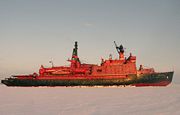
Nuclear power
Nuclear power is the use of sustained nuclear fission to generate heat and electricity. Nuclear power plants provide about 6% of the world's energy and 13–14% of the world's electricity, with the U.S., France, and Japan together accounting for about 50% of nuclear generated electricity...
in the Soviet icebreaker Lenin
Soviet icebreaker Lenin
The NS Lenin is a Soviet icebreaker launched in 1957, and is both the world's first nuclear powered surface ship and the first nuclear powered civilian vessel. Lenin was put into operation in 1959 and officially decommissioned in 1989....
in 1959 that icebreakers developed their full potential. NS Lenin was launched in 1957. It was both the world's first nuclear powered surface ship
Nuclear marine propulsion
Nuclear marine propulsion is propulsion of a ship by a nuclear reactor. Naval nuclear propulsion is propulsion that specifically refers to naval warships...
and the first nuclear powered civilian vessel. Lenin was put into operation in 1959 and officially decommissioned in 1989.
The second Soviet nuclear icebreaker was NS Arktika
Arktika (icebreaker)
NS Arktika is a nuclear powered icebreaker of the Soviet Arktika class. In service since 1975, she was the first surface ship to reach the North Pole, on August 17, 1977....
, the pilot of the Arktika class
Arktika class icebreaker
The Arktika class is a Russian class of nuclear powered icebreakers. They are owned by the federal government, but were operated by the Murmansk Shipping Company until 2008, when they were transferred to the fully government-owned operator Atomflot. Of the ten civilian nuclear powered vessels...
. In service since 1975, she was the first surface ship to reach the North Pole
North Pole
The North Pole, also known as the Geographic North Pole or Terrestrial North Pole, is, subject to the caveats explained below, defined as the point in the northern hemisphere where the Earth's axis of rotation meets its surface...
, on August 17, 1977.
In May 2007, sea trials were completed for the nuclear-powered Russian ice-breaker NS 50 Let Pobedy. The vessel was put into service by Murmansk
Murmansk
Murmansk is a city and the administrative center of Murmansk Oblast, Russia. It serves as a seaport and is located in the extreme northwest part of Russia, on the Kola Bay, from the Barents Sea on the northern shore of the Kola Peninsula, not far from Russia's borders with Norway and Finland...
Shipping Company, which manages all eight Russian state-owned nuclear icebreakers. The keel was originally laid in 1989 by Baltic Works of Leningrad
Leningrad
Leningrad is the former name of Saint Petersburg, Russia.Leningrad may also refer to:- Places :* Leningrad Oblast, a federal subject of Russia, around Saint Petersburg* Leningrad, Tajikistan, capital of Muminobod district in Khatlon Province...
(now St Petersburg), and the ship was launched in 1993 as the NS Ural. This icebreaker was intended to be the sixth and last of the Arktika
Arktika class icebreaker
The Arktika class is a Russian class of nuclear powered icebreakers. They are owned by the federal government, but were operated by the Murmansk Shipping Company until 2008, when they were transferred to the fully government-owned operator Atomflot. Of the ten civilian nuclear powered vessels...
class, and currently is the world's largest icebreaker.
Function of icebreakers
Icebreakers are needed to keep trade routes open where there are either seasonal or permanent ice conditions. Icebreakers are expensive to build and very expensive to run, whether the icebreaker is powered by gas turbineGas turbine
A gas turbine, also called a combustion turbine, is a type of internal combustion engine. It has an upstream rotating compressor coupled to a downstream turbine, and a combustion chamber in-between....
s, diesel-electric
Diesel-electric
Diesel-electric transmission or diesel-electric powertrain is used by a number of vehicle and ship types for providing locomotion.A diesel-electric transmission system includes a diesel engine connected to an electrical generator, creating electricity that powers electric traction motors...
powerplant or nuclear energy
Nuclear powered icebreaker
A nuclear powered icebreaker is a purpose-built ship for use in waters continuously covered with ice. Icebreakers are ships capable of cruising on ice-covered water by breaking through the ice with their strong, heavy, steel bows...
. They are uncomfortable to travel in on the open sea: almost all of them have thick, rounded keels, and with no protuberances for stability
Stability conditions (watercraft)
Stability conditions is the term used to describe the various standard loading configurations to which a ship, boat, or offshore platform may be subjected. They are recognized by classification societies such as Lloyd's Register, American Bureau of Shipping and Det Norske Veritas...
, they can roll even in light seas. They are also uncomfortable to travel in when breaking through continuous thick ice due to constant motion, noise, and vibration.
A modern icebreaker typically has shielded propellers both at the bow and at the stern, as well as side thrusters; pumps to move water ballast from side to side; and holes on the hull below the waterline to eject air bubbles, all designed to allow an icebreaker stuck amidst thick ice to break free. Many icebreakers also carry aircraft (formerly seaplane
Seaplane
A seaplane is a fixed-wing aircraft capable of taking off and landing on water. Seaplanes that can also take off and land on airfields are a subclass called amphibian aircraft...
s but now helicopter
Helicopter
A helicopter is a type of rotorcraft in which lift and thrust are supplied by one or more engine-driven rotors. This allows the helicopter to take off and land vertically, to hover, and to fly forwards, backwards, and laterally...
s) to assist in reconnaissance and liaison.
Design and construction
Icebreakers are constructed with a double hullDouble hull
A double hull is a ship hull design and construction method invented by Leonardo da Vinci where the bottom and sides of the ship have two complete layers of watertight hull surface: one outer layer forming the normal hull of the ship, and a second inner hull which is some distance inboard,...
and watertight compartments in case of a breach. The ship's hull is thicker than normal, especially at the bow, stern, and waterline, using special steel that has optimum performance at low temperatures. The thicker steel at the waterline typically extends about 1 m above and below the waterline and is reinforced with extra internal ribbing, sometimes twice the ribbing of a normal ship. The bow is rounded rather than pointed, allowing the vessel to ride up over the ice, breaking it with the weight of the vessel. The hull has no appendages likely to be damaged by the ice, and the rudder and propeller are protected by the shape of the hull. The propeller blades are strengthened, and the vessel has the ability to inspect and replace blades while at sea.
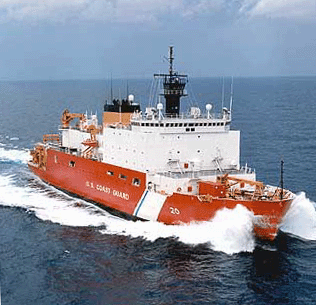
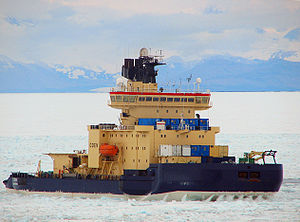
Free surface
In physics, a free surface is the surface of a fluid that is subject to constant perpendicular normal stress and zero parallel shear stress,such as the boundary between two homogenous fluids,for example liquid water and the air in the Earth's atmosphere...
. Retarding baffles inside the anti-roll tank slow the side-to-side flow of water. By varying the water level inside the anti-roll tank, the natural frequency of the slosh is used to counteract the rolling of the vessel. Anti-roll tanks by their nature decrease a ship's stability and must always be used with caution. Use of computer-controlled valves allow for better control of these anti-roll tanks. A greater concern is how well a ship cuts through waves. The ability of a ship to cut through waves can greatly affect its fuel efficiency and even its safety in a storm. Most ships use a sharp or bulbous bow
Bulbous bow
A bulbous bow is a protruding bulb at the bow of a ship just below the waterline. The bulb modifies the way the water flows around the hull, reducing drag and thus increasing speed, range, fuel efficiency, and stability...
to cut through waves and help prevent waves from slamming the bow of the ship. However, icebreakers have a round sled-like bow. They tend to slam into waves, which can be risky in high seas.
Recent advances
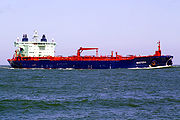
Azimuth thruster
An azimuth thruster is a configuration of ship propellers placed in pods that can be rotated in any horizontal direction, making a rudder unnecessary...
remove the need of traditional propellers and rudders by having the propellers in steerable pods that can rotate 360 degrees along the vertical axis. These thrusters, often referred to as Azipod
Azipod
Azipod is the registered brand name of the ABB Group for their azimuth thruster. Originally developed in Finland jointly by Kvaerner Masa-Yards dockyards and ABB, these are marine propulsion units consisting of electrically driven propellers mounted on a steerable pod.The pod's propeller usually...
s after ABB's brand of podded propulsion, improve propulsion efficiency, icebreaking capability and steering. The use of azimuth thrusters also allows a ship to move astern in ice without losing maneuverability, which has led to the development of double acting ship
Double acting ship
Double acting ship is a type of icebreaking merchant ship designed to run ahead in open water and astern in ice...
s, vessels with the stern shaped like an icebreaker's bow. This allows the bow to be designed for open water performance without compromising the ship's ability to operate in difficult ice conditions.
There has also been some research done to make a bulbous bow
Bulbous bow
A bulbous bow is a protruding bulb at the bow of a ship just below the waterline. The bulb modifies the way the water flows around the hull, reducing drag and thus increasing speed, range, fuel efficiency, and stability...
for ferries and cargo ships that can make the initial break in the ice, not by sledding up on top of the ice, but by pushing it up from undeneath, so as to spare the rest of the hull from the impact that would otherwise occur, thus keeping the speed up. This also has marked advantages in wavebreaking and fuel efficiency, but breaking thicker ice may be limited, since it has to be able to reach under the ice in the first place. It is mostly used in conditions where ice thickness is limited.
See also
- List of icebreakers
- Nuclear-powered icebreaker
- Double acting shipDouble acting shipDouble acting ship is a type of icebreaking merchant ship designed to run ahead in open water and astern in ice...
- Resonance method of ice destructionResonance method of ice destructionThe Resonance method of ice destruction can be used by any vehicle capable of traveling on ice cover with sufficient speed and imposing sufficient load. There have been cases of destruction of ice by flexural gravity waves produced by moving cars, trains on railway crossings, aircraft during...
External links
- Ice breaker by Picture
- Gallery of Russian icebreakers
- "Ice heroes": Read a Q&A with Canadian Coast Guard acting commanding officer.
- Canadian Geographic: View a Canadian Coast Guard slideshow.
- Pushing the Limits Short history of Russian icebreakers by Roderick Eime
- Icebreaker at the North Pole: Video of nuclear icebreaker Yamal visiting the North Pole in 2001
- Book Polar Icebreakers in a Changing World: An Assessment of U.S. Needs (2007)

